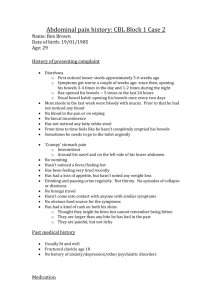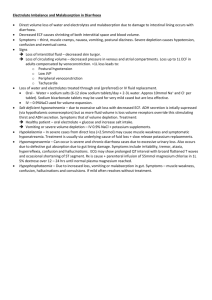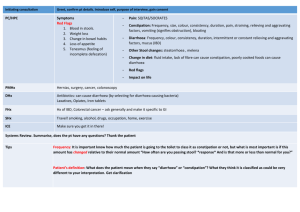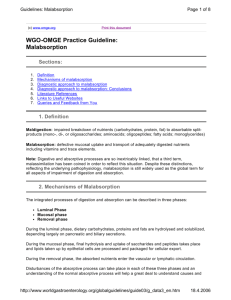Guidelines for the investigation of chronic diarrhoea, 2nd edition
advertisement
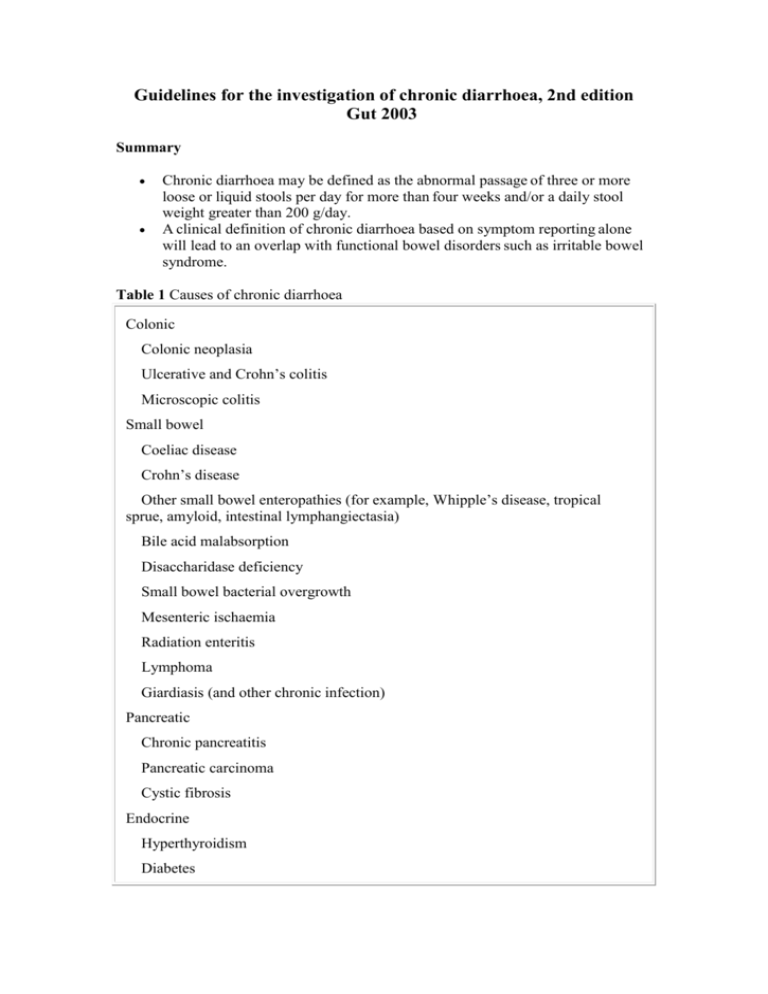
Guidelines for the investigation of chronic diarrhoea, 2nd edition Gut 2003 Summary Chronic diarrhoea may be defined as the abnormal passage of three or more loose or liquid stools per day for more than four weeks and/or a daily stool weight greater than 200 g/day. A clinical definition of chronic diarrhoea based on symptom reporting alone will lead to an overlap with functional bowel disorders such as irritable bowel syndrome. Table 1 Causes of chronic diarrhoea Colonic Colonic neoplasia Ulcerative and Crohn’s colitis Microscopic colitis Small bowel Coeliac disease Crohn’s disease Other small bowel enteropathies (for example, Whipple’s disease, tropical sprue, amyloid, intestinal lymphangiectasia) Bile acid malabsorption Disaccharidase deficiency Small bowel bacterial overgrowth Mesenteric ischaemia Radiation enteritis Lymphoma Giardiasis (and other chronic infection) Pancreatic Chronic pancreatitis Pancreatic carcinoma Cystic fibrosis Endocrine Hyperthyroidism Diabetes Hypoparathyroidism Addison’s disease Hormone secreting tumours (VIPoma, gastrinoma, carcinoid) Other Factitious diarrhoea "Surgical" causes (e.g. small bowel resections, internal fistulae) Drugs Alcohol Autonomic neuropathy Initial investigations : Summary and recommendations Screening blood tests should include full blood count, erythrocyte sedimentation rate, C reactive protein, urea and electrolytes, liver function tests, calcium, vitamin B12, folate, iron studies, and thyroid function. These have a high specificity but low sensitivity for the presence of organic disease (B). Although infectious diarrhoea is uncommon in immunocompetent patients from the developed world with chronic symptoms, stool cultures and stool microscopy should be performed (C). Coeliac disease is the most common small bowel enteropathy in Western populations. Patients with diarrhoea should be screened for this using serological tests (currently antiendomysium antibodies), which have a high sensitivity and specificity for the disease (A). Factitious diarrhoea becomes increasingly common in specialist referral practice, and screening for laxative abuse should be performed early in the course of investigation (B). SMALL AND LARGE BOWEL MUCOSAL DISEASE : Summary and recommendations. In patients less than 45 years with typical symptoms of functional bowel disease, normal examination, and normal screening blood tests, a positive diagnosis can be made and no further investigation is necessary (C). Patients less than 45 years with chronic diarrhoea and/or atypical symptoms should undergo flexible sigmoidoscopy in the first instance as the diagnostic yield differs little from the use of colonoscopy in this age group (B). In patients over 45 years with chronic diarrhoea, colonoscopy (with ileoscopy) is the preferred investigation. This may yield abnormalities in up to 30% of cases, has a better sensitivity than barium enema, and allows sampling of the colonic mucosa for histological examination (B). Antiendomysium antibody testing is currently the preferred firstline test for coeliac disease but if negative and small bowel malabsorption is suspected, upper gastrointestinal endoscopy with distal duodenal biopsies should be performed to assess for the presence of other small bowel enteropathies (C). Small bowel imaging (barium follow through or enteroclysis) should be reserved for cases where small bowel malabsorption is suspected and distal duodenal histology is normal (C). 99m Technetium hexa-methyl-propyleneamine oxime (Tc-HMPAO) labelled white cell scanning is a non-invasive useful technique to examine for intestinal inflammation and has equivalent sensitivity to small bowel follow through in the assessment of terminal ileal Crohn’s disease (B). NON-INVASIVE TESTS FOR MALABSORPTION: Summary and recommendations Quantification of three day faecal fat is poorly reproducible, unpleasant, and non-diagnostic, and its use should be discouraged (C). Single stool analyses such as faecal fat concentration and semiquantitative methods such as acid steatocrit correlate moderately well with three day faecal fat quantification and offer an alternative method of assessing fat malabsorption but are not readily available in most centres. Newer specific tests of pancreatic dysfunction, such as stool elastase, are preferred (B). Breath tests for fat malabsorption include 14C-triolein or a 13C labelled mixed triglyceride as substrates. These have a low sensitivity for mild or moderate fat malabsorption but where available may serve as an alternative to faecal fat collection (B). Non-invasive investigations for small bowel enteropathy such as urine or serum D-xylose testing, although of high sensitivity in clinical studies, often have a poor performance in routine practice and have largely been superseded by the availability of small bowel histology. Their use is not encouraged (C). INVESTIGATION OF MALABSORPTION DUE TO PANCREATIC INSUFFICIENCY : Summary and recommendations Severe pancreatic insufficiency with malabsorption is normally associated with pancreatic duct abnormalities. At present ERCP offers the greatest sensitivity for the diagnosis of ductal changes. However, MRCP has the potential to replace ERCP as the imaging modality of choice and has the advantage of avoiding the risks associated with ERCP (B). Non-invasive pancreatic function tests include urine tests such as the Pancreolauryl test and stool tests such as faecal elastase or chymotrypsin. They depend on a significant loss of exocrine function and thus are only reliable in moderate/severe pancreatic disease, with poor sensitivity for mild disease (B). Non-invasive tests have approximately equivalent sensitivities for the detection of pancreatic insufficiency (B). Faecal elastase offers the advantages of acceptable reliability and convenience (a single stool sample is required) without the need for prolonged urine collections, and is therefore recommended as the test of first choice in patients who present with diarrhoea of putative pancreatic origin (C). INVESTIGATION OF CHRONIC DIARRHOEA DUE TO SPECIFIC CONDITIONS : Summary and recommendations Culture of small bowel aspirates is the most sensitive test for SBBO but methods are poorly standardised and positive results may not reflect clinically significant SBBO (B). Hydrogen breath tests have poor sensitivity but acceptable specificity, and are of value when a positive result is obtained. The glucose hydrogen breath test is recommended (B). In the absence of an optimal test for the presence of bacterial overgrowth, an empirical trial of antibiotics is often used; the value of this approach has not been subject to critical study (C). Bile acid malabsorption (BAM) may occur when there is terminal ileal disease or resection. Measurement of serum 7 hydroxy-4-cholesten-3-one is an effective test for this but is seldom performed. 75Se homotaurocholate (75SeHCAT) testing is more widely available and is a sensitive measure of BAM (B). In the absence of these tests a therapeutic trial of cholestyramine is sometimes employed as a test for the presence of BAM, but the validity of this approach has not been subject to study (B). Diarrhoea due to hormone secreting tumours is extremely rare and testing for the presence of excess vasoactive intestinal peptide, gastrin, or glucagon in plasma is recommended only in the presence of high volume watery diarrhoea when other causes of diarrhoea have been excluded (C). SUMMARY AND CONCLUSIONS Establishing a clear definition of diarrhoea based on history alone can prove difficult, and this tends to lead to over investigation of functional bowel disorders such as IBS. However, in the majority of such patients typical symptoms and negative initial investigations yield a positive diagnosis. In those patients where there is doubt, inspection of the stool and measurement of stool weight may prove helpful in clarifying whether there is true "diarrhoea" or functional disease. Initial investigations should include full blood count, erythrocyte sedimentation rate, electrolytes, liver function tests, iron studies, vitamin B12, folate, and thyroid function. Screening tests such as serum antiendomysium antibodies for coeliac disease, the most common small bowel enteropathy in European populations, should be performed early in the course of investigations. The initial assessment should direct the clinician to determine whether further investigation is necessary and, if so, whether the focus should be on colonic, small bowel, or pancreatic disease. This analysis could reasonably be performed in the primary care setting. Most chronic diarrhoea is due to colonic disease, and in the absence of clinical evidence for malabsorption, investigations should focus on the lower gastrointestinal tract in the first instance. Colonic investigations should be age stratified, in keeping with the risk of neoplasia. This risk is greater in those with one or more first degree relatives with colorectal cancer and in males. Full colonic imaging is recommended in those over 45 years of age, preferably with colonoscopy. In patients younger than this the diagnostic yield of flexible sigmoidoscopy and biopsy is not substantially different from colonoscopy, and sigmoidoscopy can therefore be the preferred investigation. Patients with malabsorption represent a small proportion of presentations with chronic diarrhoea. Supporting history may direct investigations towards either the small bowel or pancreas. Serological testing for coeliac disease will determine most cases without invasive investigation, but individuals suspected to have small bowel malabsorption, despite negative coeliac serology, should have endoscopic distal duodenal biopsies taken to exclude other rarer forms of small bowel enteropathy. This strategy has largely supplanted many of the older tests of small bowel function. Non-invasive tests for pancreatic insufficiency currently depend on the presence of at least moderate impairment of exocrine function before they achieve adequate sensitivity. There are indirect functional tests such as the BTP/PABA and Pancreolauryl tests, and more direct tests of pancreatic enzymes (such as elastase or chymotrypsin) in the stool. Although the sensitivities and specificities are similar, faecal elastase is preferred because of its ease of use. These tests are reasonably specific for pancreatic malabsorption and are preferred over tests for faecal fat, which do not adequately discriminate between small bowel and pancreatic malabsorption. The three day faecal fat is often unreliable in clinical practice and is no longer recommended. The optimal investigation for small bowel bacterial overgrowth remains unclear. Culture of jejunal aspirates or unwashed small bowel biopsies remains the gold standard and should be encouraged whenever the diagnosis is seriously considered. The sensitivity of hydrogen breath tests is only approximately 60%, with little difference between 14C-D-xylose and glucose. Their specificity is approximately 75%, which is better than for lactulose hydrogen breath testing. Given the apparent deficiencies in the current methods for establishing diagnoses of pancreatic insufficiency, bile acid malabsorption, and small bowel bacterial overgrowth, an empirical trial of therapy is often employed. The diagnostic value of this approach has not been subject to evaluation. Despite extensive and exhaustive investigations, some cases will resist a definitive diagnosis. Although no study has formally assessed an investigative protocol for chronic diarrhoea such as that described, it is estimated that approximately two thirds of cases can be diagnosed using such an approach. The remaining patients will be those with watery, secretory, self limiting "idiopathic" diarrhoea (presumably infective), or undiagnosed factitious diarrhoea.13,23,213 Since in the majority of these cases the overall prognosis appears to be good, further investigation in this group is not warranted and symptomatic treatment should be instituted. algorithm for the investigation of chronic diarrhoea (see text for details). FBC, full blood count; LFT, liver function tests; CT, computerised tomography; ERCP, endoscopic retrograde cholangio- pancreatography; MRCP, magnetic resonance cholangio- pancreatography; Tc-HMPAO, technetium hexa-methylpropyleneamine oxime; 75Se-HCAT, 75Se homotaurocholate; 5HIAA, 5hydroxyindoleacetic.
